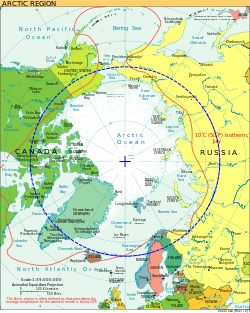| Icebreaker Collaboration Effort | |
|---|---|
 Finnish President Alexander Stubb, U.S President Joe Biden and Canadian Prime Minister Justin Trudeau at the Walter E. Washington Convention Center in Washington, D.C. | |
| Type | Tripartite treaty |
| Signed | 11 July 2024 |
| Location | Washington, D.C. United States |
| Original signatories |
|
| Signatories |
|
| Languages |
|
The Icebreaker Collaboration Effort, commonly referred to as the ICE Pact, is a trilateral partnership between the United States, Canada and Finland. [1] The ICE Pact was formed on 11 July 2024 in Washington, D.C. [2] The ICE Pact is a partnership in efforts to bolster shipbuilding capacities and industries, especially the enhancing of icebreaker ship production capacity in Canada and Finland, and to counter the influence of the Russian Federation and China in the Arctic region. [3] [4]
Contents
The United States formed the ICE Pact to strengthen the United States Coast Guard and to accelerate icebreaker shipbuilding for itself and allies with assistance from Finland and Canada. [5] [6] The country of manufacture is yet to be determined; US rules currently require navy ships to be manufactured in the United States, but not privately owned ships [7] (though there are Jones Act (Merchant Marine Act of 1920) restrictions on transport services). Canada has contracted for one heavy icebreaker from Seaspan ULC in British Columbia and plans to contract a second from Davie Shipbuilding in Quebec. [8] Canada has contracted 16 icebreaking multipurpose vessels from Seaspan (currently in functional design as of August 2024 with detailed design starting in the first half of 2025) and 6 medium icebreakers from Davie (initial contract was awarded in March 2024). [9] Finland has "know-how"; Helsinki Shipyard has built more than half of the world's icebreakers. [10] [11] The US has an overall goal of 70-90 Arctic-capable ships built within a decade. [12] [13] Canada is mainly to help with the ramping up and scaling of icebreaker ship building capacity. [13]
On 13 November 2024, in Washington, D.C., representatives from Canada, the United States and Finland signed a Memorandum of Understanding (MOU) to collaborate on building icebreakers for the Arctic region. [14]
Finland and the United States have signed a memorandum of understanding on icebreaker cooperation. Finnish President Alexander Stubb and US President Donald Trump signed the memorandum of understanding in connection with their meeting in Washington on 9 October 2025. Finnish Prime Minister Petteri Orpo participated in the meeting between the presidents. The Finnish-US memorandum of understanding on icebreaker cooperation lays the foundation for commercial agreements between the US Coast Guard and Finnish companies. [15]
On 18 November 2025, Department of Homeland Security, DHS Sec. Kristi Noem, Canadian Ambassador Kirsten Hillman and Finland’s Minister of Economic Affairs Sakari Puisto signed a letter of intent to join forces under the Icebreaker Collaboration Effort.

